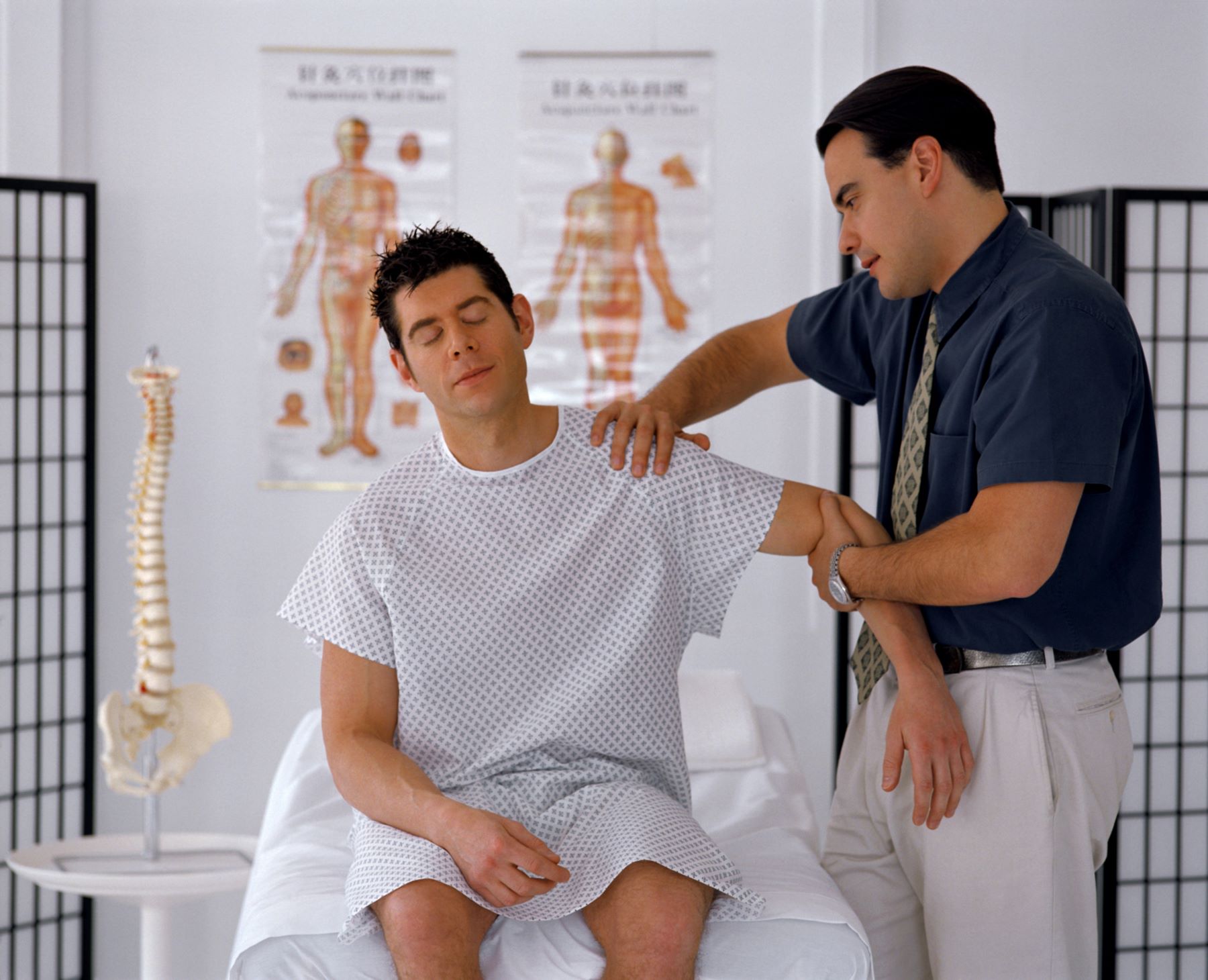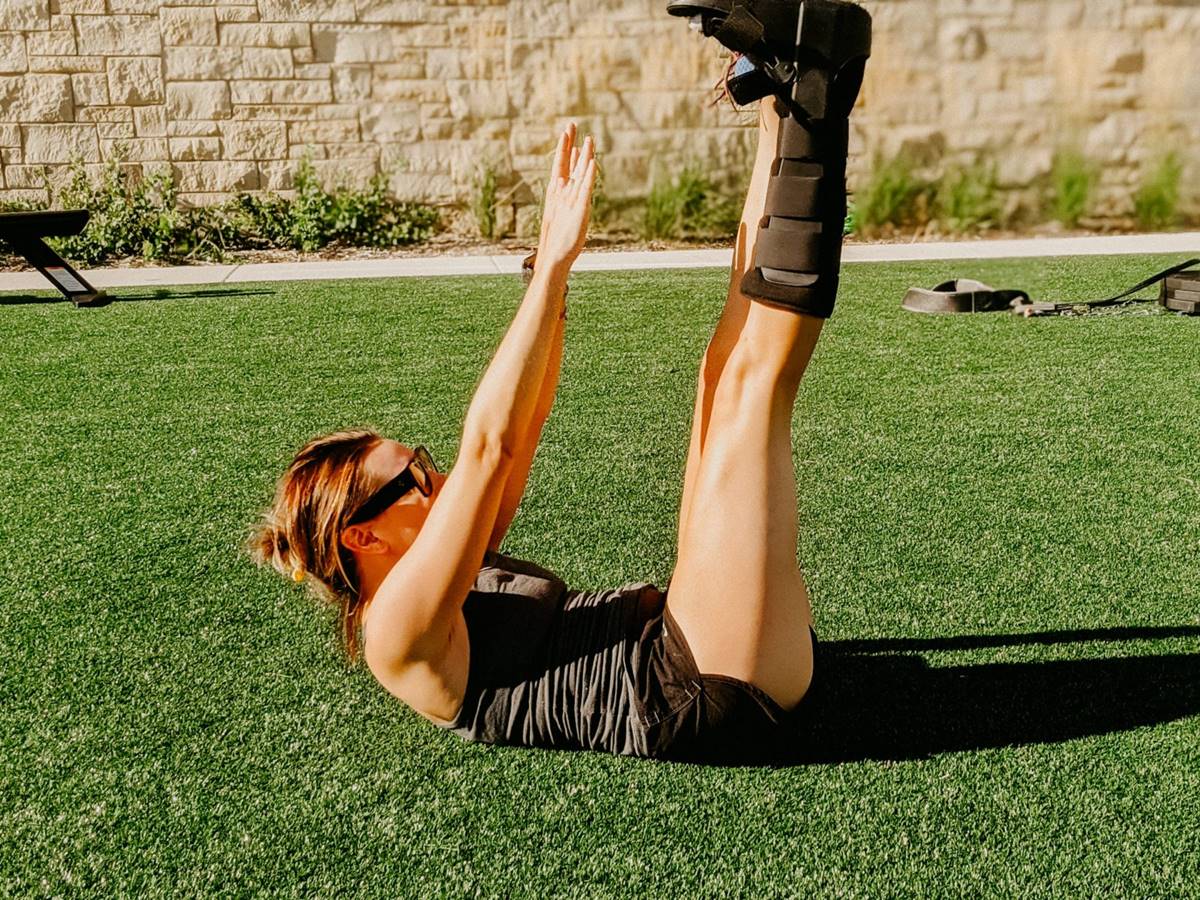

Featured
What Is ROM Exercise
Published: September 29, 2023
Learn about the benefits and importance of ROM exercise for improved flexibility and muscle strength. Discover how to incorporate ROM exercises into your fitness routine. Featured.
Introduction
Welcome to our comprehensive guide on ROM exercise! Whether you’re a fitness enthusiast, an athlete, or someone looking to improve their overall well-being, understanding the concept and benefits of ROM exercise is essential. ROM, which stands for Range of Motion, refers to the movement capabilities of our joints and muscles.
ROM exercise focuses on improving and maintaining the full range of motion in our joints, allowing us to move more freely and perform daily activities with ease. It involves performing specific movements and stretches that target different muscle groups and joint complexes.
While traditional exercise routines often prioritize strength or endurance, ROM exercise emphasizes flexibility, mobility, and joint health. By incorporating ROM exercises into your fitness regimen, you can enhance your overall physical performance, reduce the risk of injuries, and improve your quality of life.
In this guide, we will delve into the definition, benefits, types, and examples of ROM exercise. We will also provide you with important safety guidelines, precautions, and considerations to help you make the most out of your ROM exercise routine.
So, whether you’re a beginner who is new to ROM exercises or someone looking to deepen their knowledge and refine their technique, this guide has got you covered. Let’s dive into the world of ROM exercise and discover the incredible benefits it can bring to your physical well-being!
Definition of ROM Exercise
Range of Motion (ROM) exercise is a type of physical activity that aims to improve and maintain the full range of motion in our joints. It involves performing controlled movements and stretches that target specific muscles and joint complexes. The goal of ROM exercise is to enhance flexibility, mobility, and joint health.
Range of motion refers to the distance and direction that a joint can move between its fully flexed and extended positions. It is crucial for the smooth functioning of our joints and muscles, as well as the overall performance of our bodies. Factors such as age, lifestyle, injuries, and sedentary habits can affect our range of motion, leading to stiffness, decreased mobility, and increased risk of injuries.
ROM exercise is designed to address these issues by gently and progressively stretching the muscles and connective tissues around the joints. By performing a wide range of movements, such as rotations, extensions, flexions, and lateral movements, ROM exercises can help maintain and even improve your joint mobility.
One of the key aspects of ROM exercise is the emphasis on controlled movements. Unlike other forms of exercise that may involve rapid or forceful movements, ROM exercises focus on slow and deliberate actions. This approach helps to prevent injury and allows for better muscular control and activation during the exercise.
ROM exercise can be performed by individuals of all fitness levels and ages. It is often recommended for rehabilitation purposes, as it can aid in the recovery from joint injuries, surgeries, or conditions such as arthritis. Additionally, it can be incorporated into regular fitness routines to improve overall joint health and prevent future injuries.
In the next sections, we will explore the numerous benefits of ROM exercise, the different types of ROM exercises you can try, and how to properly perform them. So, let’s continue our journey into the world of ROM exercise!
Benefits of ROM Exercise
Engaging in regular ROM exercise can offer a multitude of benefits for both your physical and mental well-being. Let’s explore some of the key advantages of incorporating ROM exercises into your fitness routine:
- Improved Joint Flexibility: ROM exercises focus on stretching and mobilizing the joints, helping to increase their flexibility and range of motion. This can be especially beneficial for individuals with stiff joints due to sedentary lifestyles, injuries, or age-related factors.
- Enhanced Muscle Flexibility: Performing ROM exercises can help stretch and lengthen the muscles surrounding the joints. This increased flexibility can improve overall muscle function and mobility, leading to better exercise performance, reduced muscle imbalances, and decreased risk of injuries.
- Increased Joint Stability: ROM exercises target the muscles and ligaments that support the joints. By strengthening these structures, ROM exercise can enhance joint stability, reducing the risk of sprains, strains, and other joint-related injuries.
- Improved Posture: Poor posture is a common issue resulting from muscle imbalances and limited range of motion. Regular ROM exercises can help correct posture by releasing tension in tight muscles, improving alignment, and promoting a more upright and balanced body position.
- Enhanced Performance: Incorporating ROM exercises into your fitness routine can have a positive impact on your overall athletic performance. Improved joint flexibility and muscle elasticity can enhance your ability to move efficiently, leading to better agility, strength, and coordination in sports and everyday activities.
- Reduced Pain and Discomfort: ROM exercises can help alleviate pain and discomfort associated with joint stiffness, muscle tightness, and certain musculoskeletal conditions. The gentle stretches and controlled movements promote blood flow, release tension, and can provide relief for individuals suffering from conditions like arthritis or chronic pain.
- Enhanced Mind-Body Connection: ROM exercise often involves mindful movement and focused breathing, which can promote a stronger connection between the mind and body. This can help reduce stress, improve relaxation, and foster a sense of well-being.
These are just a few of the many benefits that ROM exercise can offer. Whether you’re an athlete looking to improve performance, someone recovering from an injury, or simply seeking to enhance your overall physical well-being, incorporating ROM exercises into your fitness routine can be highly advantageous.
In the following sections, we will explore different types of ROM exercises and provide guidelines on how to properly perform them. So, let’s continue our journey into the world of ROM exercise!
Types of ROM Exercise
There are various types of ROM exercises that target different muscle groups and joint complexes. Let’s explore some of the common types of ROM exercises:
- Passive Range of Motion: Passive ROM exercises involve using an external force, such as a partner, therapist, or equipment, to move a joint through its full range of motion. This type of exercise is often used in rehabilitation settings to help maintain joint mobility when an individual is unable to move the joint independently.
- Active Range of Motion: Active ROM exercises involve actively moving a joint through its full range of motion without the use of external assistance. This type of exercise allows for greater muscle activation and can help improve motor control and coordination.
- Assisted Range of Motion: Assisted ROM exercises are similar to passive ROM exercises but involve minimal effort from the individual. The exercises are performed with the assistance of equipment, such as resistance bands or pulleys, which provide support and facilitate movement.
- Active-Assisted Range of Motion: Active-assisted ROM exercises combine elements of active and assisted ROM exercises. They involve actively moving a joint while receiving assistance from an external force or equipment to help achieve a greater range of motion.
- Stretching Exercises: Stretching exercises are a common type of ROM exercise that focuses on lengthening and stretching the muscles surrounding a particular joint. Static stretches, dynamic stretches, and proprioceptive neuromuscular facilitation (PNF) stretching techniques can all be used to improve flexibility and range of motion.
- Joint Mobilization Exercises: Joint mobilization exercises involve applying gentle, controlled pressure or movement to a joint to improve its mobility and decrease stiffness. These exercises are often performed by trained therapists or healthcare professionals to address specific joint restrictions.
- Functional Range Conditioning: Functional Range Conditioning (FRC) is an innovative approach to ROM exercise that focuses on developing usable and functional range of motion. It combines stretching, joint mobilization, and strength training to enhance joint health, mobility, and overall movement capacity.
- Yoga and Pilates: Yoga and Pilates are both practices that incorporate ROM exercises. These disciplines utilize a combination of stretching, strength, and balance exercises to improve flexibility, stability, and body awareness.
These are just a few examples of the different types of ROM exercises available. Depending on your fitness goals, physical condition, and preferences, you can choose the type of ROM exercise that suits you best.
In the next section, we will explore how to properly perform ROM exercises to maximize their benefits. So, let’s continue our journey into the world of ROM exercise!
How to Perform ROM Exercise
Performing ROM exercises correctly is essential to ensure maximum benefit and minimize the risk of injury. Here are some general guidelines to keep in mind when performing ROM exercises:
- Warm-up: Before starting any ROM exercise, it’s crucial to warm up your muscles and joints. This can be done through light aerobic activity, such as walking or jogging, and gentle dynamic stretches to increase blood flow and prepare the body for movement.
- Start Slow: Begin with small and controlled movements, gradually increasing the range of motion as your muscles loosen up. Listen to your body and avoid pushing beyond your comfortable limit to prevent overstretching or strain.
- Breathe and Relax: Focus on deep, slow breathing throughout the exercise. This can help relax your muscles, improve oxygen flow, and enhance your mind-body connection.
- Use Proper Technique: Pay attention to your body alignment and execute each movement with proper form. Maintain a good posture, engage the appropriate muscles, and avoid any jerky or sudden movements that may strain the joints.
- Controlled Speed: Perform each movement slowly and in a controlled manner. This allows for better muscle activation and flexibility improvement, while also reducing the risk of injury.
- Full Range of Motion: Aim to move each joint through its full range of motion without forceful or painful stretching. Gradually increase the range as you become more comfortable and flexible.
- Progress Over Time: As your flexibility and range of motion improve, you can gradually increase the intensity or difficulty of the exercises. This can be done by adding resistance, increasing the duration, or exploring more challenging variations.
- Cool Down: After completing your ROM exercises, engage in a cool-down routine to gradually bring your heart rate back to normal. This can include light stretching and deep breathing to promote relaxation and muscle recovery.
Remember, it’s important to consult with a healthcare professional or qualified fitness trainer before starting any new exercise program, especially if you have any underlying health conditions or previous injuries.
In the next section, we will discuss some safety guidelines and precautions to keep in mind while performing ROM exercises. So, let’s continue our journey into the world of ROM exercise!
Safety Guidelines for ROM Exercise
While ROM exercise is generally safe for most individuals, it’s important to keep some safety guidelines in mind to ensure a safe and effective workout. Here are some key considerations:
- Consult with a Healthcare Professional: If you have any underlying health conditions, injuries, or concerns, it’s advisable to consult with a healthcare professional or qualified fitness trainer before starting a ROM exercise program. They can provide personalized guidance and ensure that the exercises are suitable for your specific needs.
- Start Slow and Progress Gradually: Begin with gentle and easy movements, gradually increasing the intensity and range of motion as your body adapts. Taking it slow allows your muscles, joints, and connective tissues to adjust and reduces the risk of strain or injury.
- Listen to Your Body: Pay attention to how your body feels during the exercises. If you experience pain, discomfort, or unusual sensations, stop the exercise and consult with a professional. Overextending or forcing a movement can lead to injuries.
- Use Proper Form: Perform each exercise with proper technique and alignment. This ensures that the targeted muscles and joints are being worked effectively and reduces the risk of strain or excessive stress on other areas of the body.
- Avoid Bouncing or Jerking Movements: Keep the movements smooth, controlled, and deliberate. Avoid bouncing or jerking motions, as these can strain the joints and lead to injury.
- Stay Hydrated: Drink plenty of water before, during, and after your workout to stay hydrated. Proper hydration helps maintain muscle function, joint lubrication, and overall performance.
- Use Suitable Equipment: If utilizing equipment for assisted or resistance-based ROM exercises, ensure that it is safe, sturdy, and appropriate for your fitness level and needs. Follow the instructions provided by the manufacturer and seek guidance if needed.
- Modify and Adapt: If you have specific physical limitations or restrictions, it’s important to modify the exercises accordingly. Work within a comfortable range of motion and modify the movements as needed to accommodate your body’s capabilities.
- Be Consistent: Consistency is key when it comes to ROM exercise. Incorporate it into your fitness routine regularly to see long-term benefits. However, remember to allow for rest and recovery days to avoid overexertion.
By following these safety guidelines, you can ensure that your ROM exercise routine is both effective and safe. However, it’s always recommended to consult with a healthcare professional or qualified fitness trainer for personalized advice and guidance.
In the next section, we will discuss some additional precautions and considerations to keep in mind when performing ROM exercises. So, let’s continue our journey into the world of ROM exercise!
Precautions and Considerations for ROM Exercise
While ROM exercise can offer numerous benefits, it’s important to be mindful of certain precautions and considerations to ensure a safe and effective workout. Here are some key factors to keep in mind:
- Medical Conditions: If you have any pre-existing medical conditions, such as arthritis, osteoporosis, or joint instability, it’s crucial to consult with a healthcare professional before starting a ROM exercise program. They can provide guidance on exercises that are safe and suitable for your specific condition.
- Pain or Discomfort: While some discomfort during stretching is normal, sharp or persistent pain should never be ignored. If you experience pain, stop the exercise and seek guidance from a professional. Pushing through pain can exacerbate injuries or cause further damage.
- Post-Surgical Considerations: If you have recently undergone surgery or have specific post-surgical restrictions, consult with your surgeon or physical therapist before engaging in ROM exercises. They can provide guidance on safe exercises and appropriate timelines for rehabilitation.
- Recent Injuries: If you have recently injured a joint or muscle, it’s important to allow proper healing time before starting ROM exercises. Rushing into movements too soon can impede the healing process and increase the risk of reinjury.
- Balance and Stability: Some ROM exercises require a certain level of balance and stability. If you have issues with balance or feel unsteady during certain movements, consider using a chair, wall, or other support to maintain stability while performing the exercises.
- Pregnancy: If you are pregnant, it’s essential to consult with your healthcare provider before engaging in any new exercise program, including ROM exercises. Certain movements may need to be modified or avoided to accommodate the changes in your body.
- Age and Fitness Level: Consider your age and fitness level when performing ROM exercises. Start with beginner-friendly exercises and gradually progress as your body becomes more accustomed to the movements. Listen to your body and avoid pushing beyond your capabilities.
- Proper Recovery and Rest: Allow your body time to rest and recover between ROM exercise sessions. Overtraining or not allowing adequate recovery time can increase the risk of injuries and hinder progress.
- Proper Clothing and Equipment: Wear comfortable and breathable clothing that allows for a full range of motion. Use proper footwear that provides support and stability. Additionally, ensure that any equipment used is in good condition and suitable for your needs.
By taking these precautions and considerations into account, you can minimize the risk of injuries and make your ROM exercise routine both safe and effective. Remember to listen to your body, be cautious, and seek professional guidance if needed.
In the next section, we will provide some examples of ROM exercises that target different muscle groups and joints. So, let’s continue our journey into the world of ROM exercise!
Examples of ROM Exercise
There are numerous ROM exercises that you can incorporate into your fitness routine to improve joint mobility, flexibility, and overall range of motion. Here are some examples of ROM exercises that target different muscle groups and joints:
- Neck Rotations: Gently rotate your neck from side to side, allowing the chin to move towards the shoulder. Perform slow and controlled movements, focusing on the full range of motion in your neck.
- Shoulder Circles: Stand tall with your arms relaxed at your sides. Slowly rotate your shoulders forward in a circular motion, then reverse direction and rotate them backward. Ensure that the movement is controlled and pain-free.
- Wrist Flexion and Extension: Extend your arm forward, palm facing down. With your other hand, gently bend your wrist downward, then upward. Repeat on the other side. This exercise helps to improve mobility and flexibility in the wrists.
- Lunges: Step forward with one foot, bending the front knee while keeping the back leg straight. Return to the starting position and repeat on the other side. Lunges help to improve lower body flexibility and range of motion in the hips and knees.
- Heel-to-Toe Walk: Stand with one foot in front of the other, placing the heel of the front foot directly in front of the toes of the back foot. Walk in a straight line, placing your heel in front of the opposite toes with each step. This exercise challenges balance, ankle mobility, and proprioception.
- Seated Trunk Twists: Sit on a chair with your feet flat on the floor. Place your hands behind your head, then twist your torso to one side, bringing your elbow towards the opposite knee. Return to the starting position and repeat on the other side. This exercise helps improve spinal mobility and stretches the muscles of the trunk.
- Hamstring Stretch: Lie on your back with one leg extended straight on the ground and the other leg raised, holding onto the back of your thigh. Gently pull your raised leg towards your chest, feeling a stretch in the back of the thigh. Switch legs and repeat the stretch. This exercise targets the hamstrings and improves flexibility in the lower body.
- Ankle Circles: Sit on a chair and extend one leg out in front of you. Rotate your ankle in a circular motion, clockwise and then counterclockwise. Switch legs and repeat. Ankle circles help to improve ankle mobility and flexibility.
- Spinal Flexion and Extension: Stand with feet shoulder-width apart and hands on your hips. Slowly bend your upper body forward, allowing your head and arms to hang down. Return to the starting position and then gently arch your back backward, looking up towards the ceiling. This exercise helps increase flexibility and mobility in the spine.
These are just a few examples of ROM exercises that you can incorporate into your routine. Remember to perform each exercise with proper form, start with a comfortable range of motion, and gradually increase the intensity as your flexibility improves.
Now that you have a variety of ROM exercises to choose from, feel free to experiment and find the ones that work best for you and target your specific needs and goals.
Before we conclude, let’s summarize what we’ve learned about ROM exercise!
Conclusion
ROM exercise is a valuable component of any fitness routine, as it focuses on improving joint mobility, flexibility, and overall range of motion. By incorporating ROM exercises into your workouts, you can reap numerous benefits, such as enhanced joint stability, improved posture, and increased athletic performance.
Throughout this guide, we have explored the definition of ROM exercise, its benefits, different types of ROM exercises, and how to properly perform them. We have also provided safety guidelines, precautions, and examples of ROM exercises targeting various muscle groups and joints.
It’s important to remember that ROM exercise should be performed with proper technique, taking into consideration individual limitations and consulting with healthcare professionals if necessary. Listening to your body, starting with a comfortable range of motion, and progressing gradually are key to reaping the full benefits of ROM exercise while minimizing the risk of injury.
Whether you’re recovering from an injury, looking to improve joint mobility, or simply aiming to enhance your overall fitness, incorporating ROM exercises into your routine can lead to significant improvements in your physical well-being.
So, what are you waiting for? Start incorporating ROM exercises into your fitness regimen and experience the positive impact on your flexibility, mobility, and overall quality of life. Remember, consistency is key, so aim to make ROM exercises a regular part of your fitness routine.
Now, go ahead and embrace the world of ROM exercise as you unlock greater joint mobility and flexibility!









